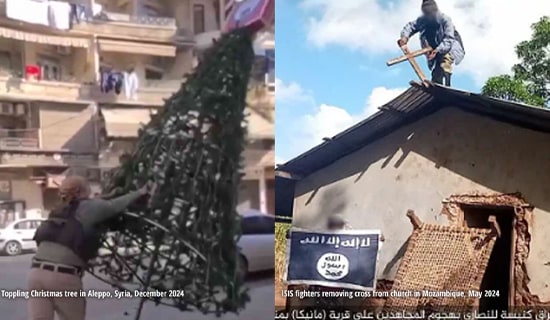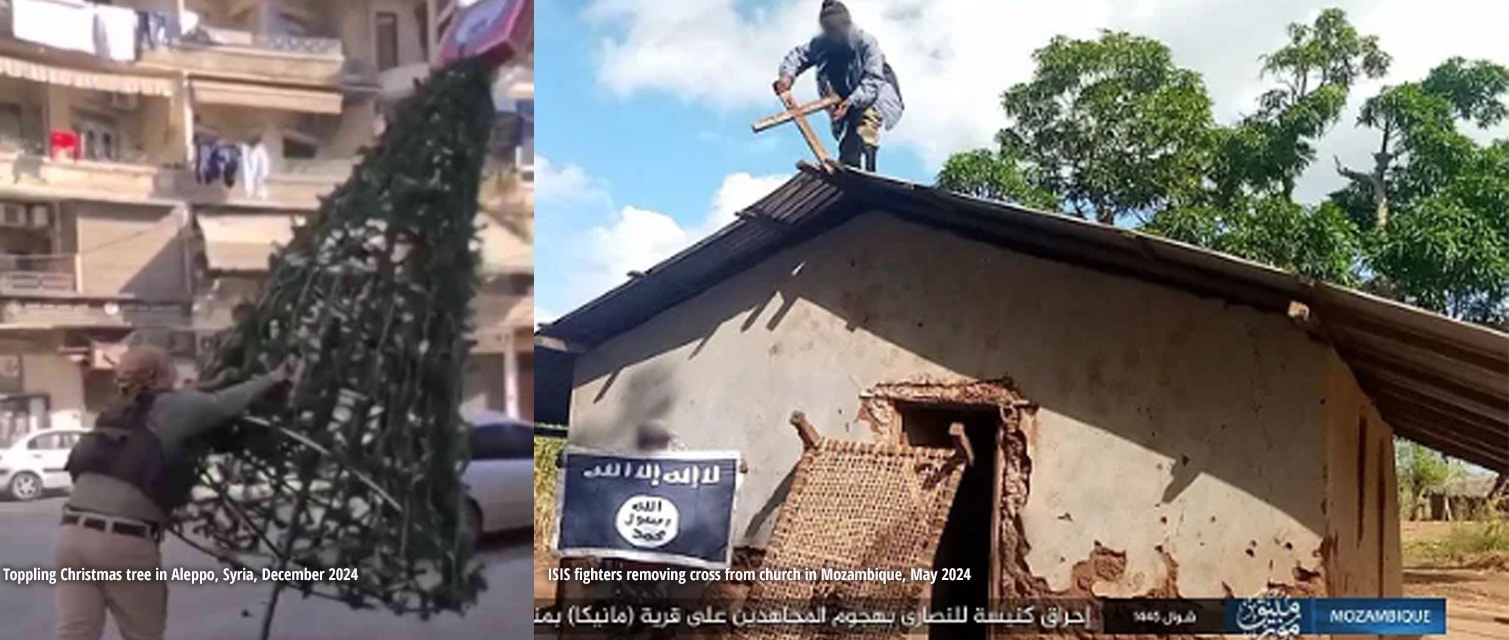Introduction
Following the passage of legislation in the U.S. Senate suspending aid to the Palestinian Authority (PA) because of the PA's extensive support for Palestinian prisoners and the families of Palestinian "martyrs" and wounded, it is being claimed in the PA that the payments and aid given to the prisoners and the families of martyrs are the same as welfare benefits given to needy families. This argument is based on the reasoning that in both cases, the family wage earner cannot work and the family is reliant on aid.[1]
However, a look at the payments to the Palestinian incarcerated and released prisoners and their families, and to families of martyrs and wounded clearly shows that these payments are in no way comparable to welfare allowances such as those provided to needy families.
The prisoners and released prisoners, who are considered a "fighting sector," and the families of the martyrs and wounded do not receive welfare; they are paid what is referred to as a "monthly salary" or a "monthly allowance." Needy families receive what is referred to as "monetary aid," which is paid out only every three months, or quarterly, as well as "non-monetary aid."
The payments to the prisoners and families of martyrs are much higher than those to needy families, which are paid out by the PA's Ministry of Social Development. The maximum monthly payment to a needy family is NIS 600 shekels per family – less than US $170 – while the maximum monthly payment to a prisoner is at least 20 times higher: it exceeds NIS 12,000 – currently about US $3,340. Furthermore, the monthly payments to prisoners and their families, released prisoners, and the families of martyrs and wounded are paid out regardless of the recipient's socioeconomic situation.
Furthermore, the prisoners and released prisoners receive a monthly allowance for themselves alone, not for their families, and its level increases in direct proportion to the length of their sentence, which obviously reflects the severity of the crime for which they are serving time. Thus, the highest payments go to prisoners who are responsible for terror operations in which people were killed (above NIS 12,000 monthly). Likewise, released prisoners who were incarcerated for over a decade also receive monthly salaries.
In addition to their salaries, prisoners receive additional payments, such as a monthly allowance of NIS 400 – over US $110 – at the prison canteen, a NIS 400 clothing allowance every six months, and more. Israeli Arab prisoners and released prisoners, who are not residents of the PA in any way, also receive a monthly salary from the PA that is NIS 500 higher than the salary of prisoners who are PA residents.
Along with monthly payments from the PA, prisoners and released prisoners and families of martyrs and wounded also enjoy a long list of benefits and grants from the PA. A comparison of the benefits for prisoners, released prisoners, and the families of martyrs with those for needy families shows that the prisoners and released prisoners receive a variety of significant benefits whose monetary value is much higher than that of the welfare benefits provided to the needy.
This report will examine the significant gaps between the PA's payments to prisoners and their families, released prisoners, and families of martyrs and the wounded and its welfare allowances to the needy, as shown by statistics in the 2017 Palestinian budget book[2] and by statistics from the PA Ministry of Social Development, which handles welfare and aid to the needy,[3] as well Palestinian laws and government decisions over the years.
Palestinian Budget Book: Payments To Prisoners Are A "Monthly Salary," Not Social Welfare
The issue of payments to prisoners and their families, and to released prisoners, appears in the section of the PA 2017 budget book concerned with the budget for the PLO institutions, under the "Plan for Protection and Care for the Prisoners and Their Families and Support and Training for Released Prisoners."[4]
The payments to the prisoners and their families, and to released prisoners, are defined in the budget book as a "monthly salary" (in Arabic, rateb shahri).[5] Conversely, needy families receive only a quarterly allowance, and the aid they receive is defined in the budget book as "monetary and non-monetary aid."[6]
The budget states that "an incarcerated prisoner receives a monthly salary,"[7] "released prisoners who served 10 years or more will receive a monthly salary equivalent to that of a civil servant," and that unemployed released prisoners who served five years or more would receive "a basic salary."[8]
It should be noted also that families of martyrs also receive their payments monthly. The definition of this type of payment in the budget book varies; in some places, it is referred to as "monthly monetary allowances" (mukhassasat maliyya shahriyya),[9] in other places as salaries (rawatib),[10] and in still others as aid (musa'ada ).[11]
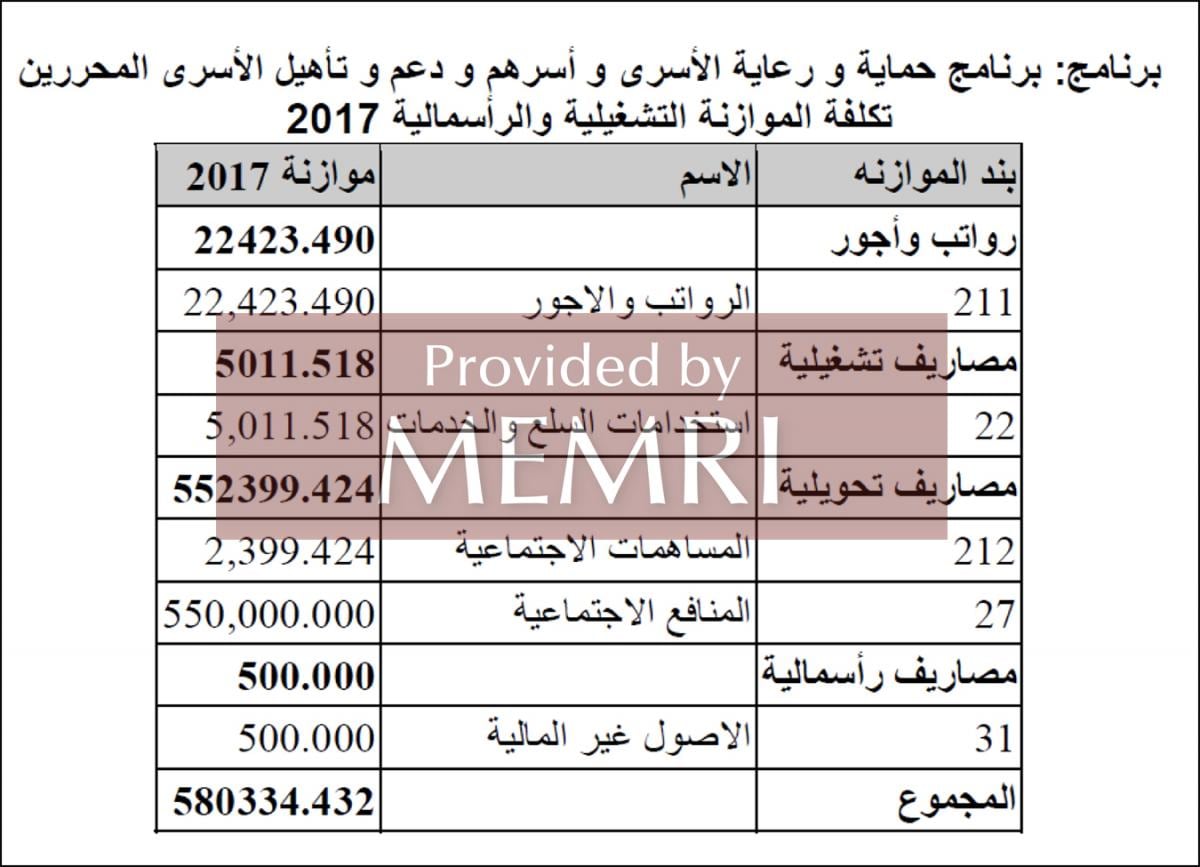
2017 Budget for the Plan for Protection and Care for the Prisoners and Their Families and Support and Training for Released Prisoners (2017 Palestinian Budget Book, page 658)
Salaries Are For Prisoners And Released Prisoners – Who Are Considered A "Fighting Sector" – Regardless Of Their Individual Economic Situations
According to Section 2 of the Amended Palestinian Prisoners Law No. 19 (2004), "the prisoners and released prisoners are a fighting sector and an integral part of the fabric of the Arab Palestinian society."[12] This perception of Palestinian prisoners is reflected by the fact that the monthly salaries and most of the benefits for both incarcerated and released prisoners are designated almost exclusively for the individuals themselves; the economic situation of their families is not a factor, and the payment of the salaries is not conditional upon the family benefiting from them.[13]
The monthly salary is paid also to unmarried prisoners who have no families to support and who cannot show that they have dependents. If a prisoner has a family, he will be paid more, even though, as noted, the salary goes to him and him alone. Married prisoners receive an extra NIS 300 per month; prisoners with children under 18 receive an extra NIS 50 per month per child.[14]
Likewise, released male prisoners who were incarcerated for over 10 years and released women prisoners who were incarcerated for over 5 years are entitled to a monthly salary "providing that they were imprisoned for opposing the occupation," regardless of their economic or family situation. They will receive a monthly salary even if they have no dependents and ample resources.[15]
As noted, the monthly salaries to prisoners are paid to the prisoners themselves, and they can use them as they see fit; it is up to them whether or not to transfer the funds to their families. In this way, even when the prisoner has dependents, there is no guarantee whatsoever that he will make his salary available to his family.
In sharp contrast, the budget of the Ministry of Social Development allocates its resources to the needy in Palestinian society in accordance with need – to residents requiring help with food, the disabled, victims of domestic violence, the elderly, and so on.[16]
Thus, because the PA provides funds to prisoners and released prisoners regardless of whether they have dependents or not, with no regard for their personal economic situations and no guarantee that the funds will help support their dependents, it is hard to accept the PA's claim that its salaries to prisoners are equivalent to social welfare payments to the needy.
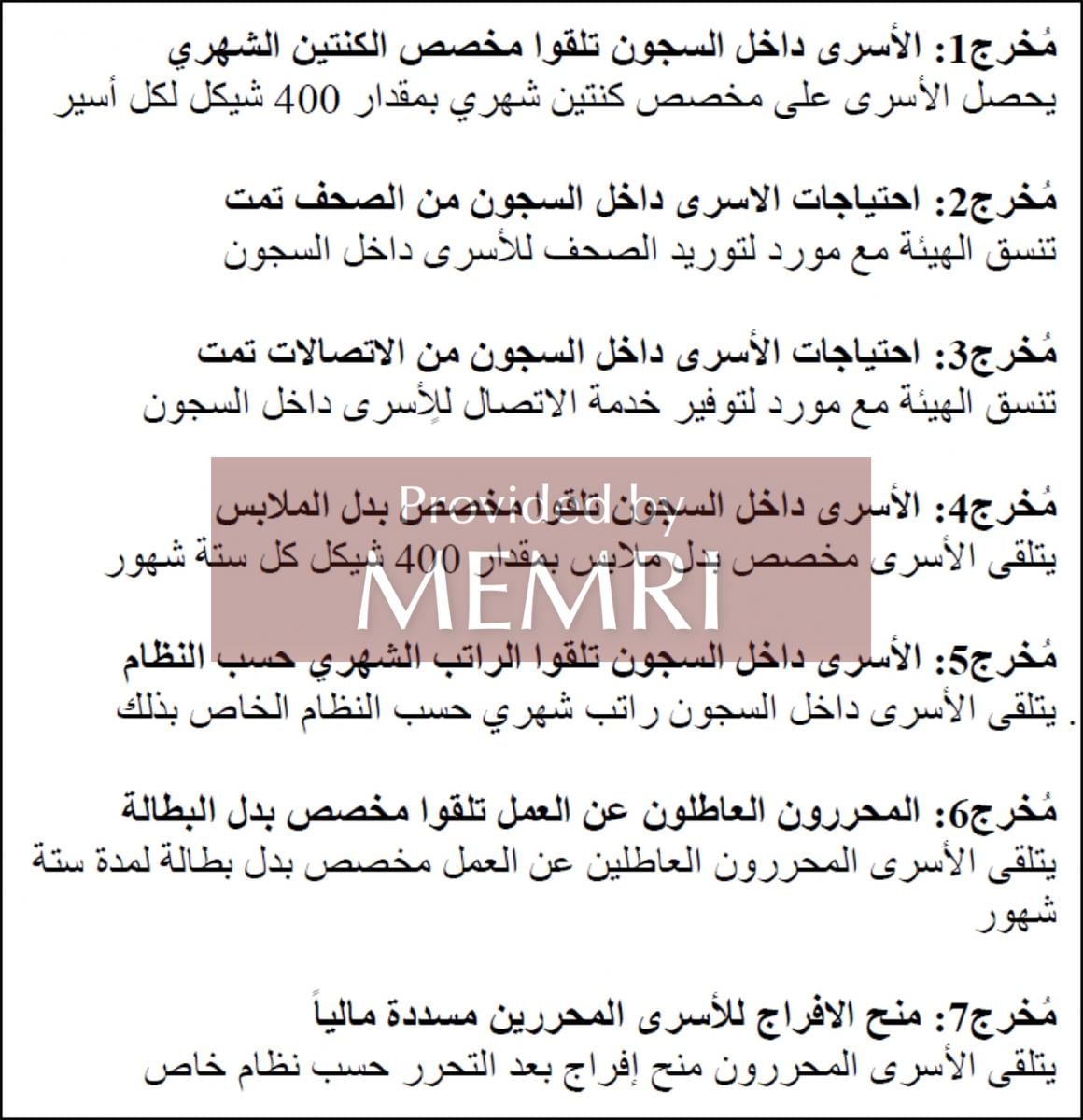
Items in 2017 budget book pertaining to monthly salaries for prisoners, and other payments (2017 Palestinian Budget Book, page 652)
The Monthly Salary Of A Prisoner Increases In Accordance With The Severity Of His Crime – Not His Socioeconomic Situation
The salaries, as noted, are paid to the prisoners themselves while they are incarcerated. The most significant criterion for the amount they receive is the length of their prison sentence, not their socioeconomic situation or their family situation. Obviously, the sentence depends on the severity of their offense, so the worse the offense, the higher the salary. In this way, the PA offers economic incentives for serious offenses involving endangering human life and murder.[17]
A prisoner serving up to three years for, say, possessing ammunition receives a basic monthly salary of NIS 1,400 (about US $390). A prisoner serving 10 to 15 years for, say, causing bodily harm or injury with a weapon receives a basic salary of NIS 6,000 (about US $1,700), and a prisoner serving 30 years or more for multiple offenses, including murder which alone gets him a 20-year sentence, receives a basic salary of NIS 12,000.[18]
The basic monthly salaries for prisoners, as per Government Decision No. 23 of 2010, are:
"Up to 3 years: NIS 1,400 (about US $390)
3-5 years – NIS 2,000 (about US $555)
5-10 years – NIS 4,000 (about US $1,111)
10-15 years – NIS 6,000 (about US $1,666)
15-20 years – NIS 7,000 (about US $1,944)
20-25 years – NIS 8,000 (about US $2,222)
25-30 years – NIS 10,000 (about US $2,777)
30 years and up – NIS 12,000." (about US $3,333) [19]

Table of monthly salaries for prisoners (in NIS) (source: Al-Waqa'i Al-Falastiniyya, Volume 90, p. 106, March 30, 2011)
Maximum Welfare Allowance For The Needy – 5% Of Maximum Salary Of Palestinian Prisoner
In accordance with Palestinian Government Decision No. 23 of 2010, the minimal salary received by a Palestinian prisoner is NIS 1,400 monthly. This sum increases in accordance with the prisoner's family status, his sentence, and where he comes from geographically.
A comparison of prisoners' salaries and Ministry of Social Development welfare allowances to the needy shows that the prisoners receive much more money; prisoners receive a basic monthly salary ranging from NIS 1,400 to NIS 12,000, while welfare recipients receive only a quarterly allowance ranging from NIS 750 (about US $209) to NIS 1,800 (about US $500),[20] or about NIS 250 ($70) to NIS 600 ($166) per month (according to the budget book these allowances are paid to 118,000 families).[21]
The minimum PA welfare allowance of NIS 250 a month is about 18% of the minimum monthly salary of a Palestinian prisoner. The maximum welfare allowance of NIS 600 a month is about 5% of the maximum monthly salary of a Palestinian prisoner. To a maximum prisoner salary of NIS 12,000 a month, supplements are added in accordance with the prisoner's family status and where he lived before his incarceration. The maximum welfare payment of NIS 600 a month is about 43% of the minimum prisoner salary.
Further proof that many needy families receive no aid from the Social Development Ministry, which is in charge of helping the poor, is that these families receive aid from the local councils. This aid is provided at the councils' discretiom and not as part of a national plan to combat poverty.[22]

Item in 2017 budget book pertaining to financial aid to needy families (2017 Palestinian Budget Book, page 383)
Payments To Families Of Martyrs And Wounded – 5.6 Times Higher Than Welfare Allowances For The Needy
The families of martyrs and wounded who reside inside and outside PA territory are also entitled to receive a monthly allowance; the minimum allowance is NIS 1,400. The family of a martyr who was married receives an additional NIS 200 a month for each child. A supplement of NIS 400 for the widow is paid if she is not working.[23] Even without the supplement for the widow, the minimal welfare allowance, of NIS 250 per month, is about 18% of the minimum allowance to the family of a martyr. The maximum welfare allowance, which is NIS 600 a month, is about 43% of the minimum allowance for the family of a martyr.
As for the Foundation for the Care of the Families of Martyrs, the PA budget book states explicitly that "the PLO's Institute for Care for the Families of Martyrs as the body "responsible for ensuring a dignified life to the families of all those martyred and wounded as a result of being participants or bystanders in the revolution."[24] But the striking difference between the allowances to the families of the martyrs and wounded and the welfare payments to the needy, along with the fact that all families of the martyrs and wounded, without exception, automatically receive an allowance while the needy must apply for an allowance and may be rejected, together create a situation in which the PA and the Palestinian institutions provide a significant economic incentive for carrying out hostile operations against Israel.
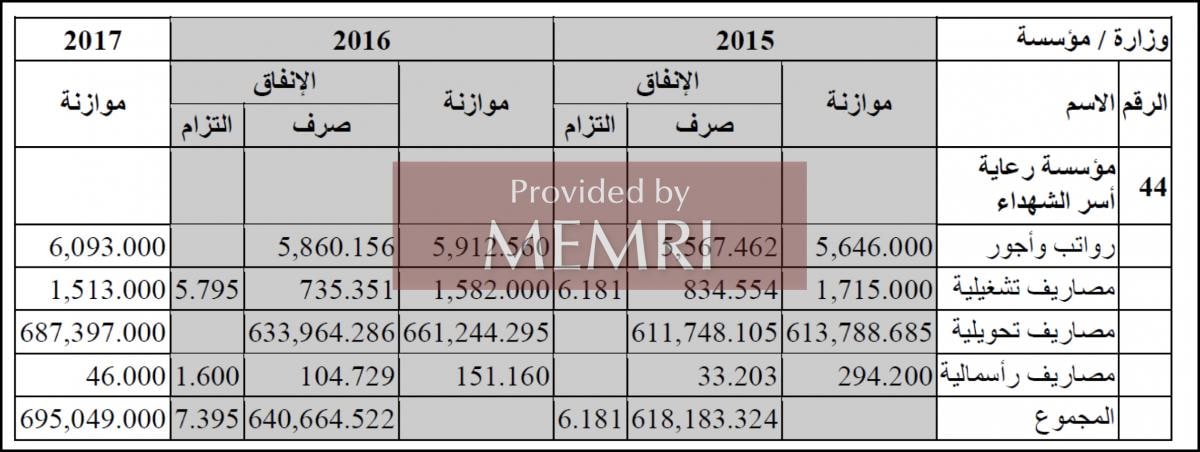
Budget of Plan for Care for the Prisoners and Their Families and Support and Training for Released Prisoners (2017 Palestinian Budget Book, page 628)
Additional Payments For Prisoners Only – Prison Canteen And Clothing Allowance
In addition to the salaries paid to the prisoners, and the significant benefits to which they are entitled, the prisoners receive from the PA a monthly allowance of NIS 400 for the prison canteen, and a clothing allowance of NIS 400 every six months. These funds are for the individual prisoners alone.[25]
Additional Payments For Israeli Arab Prisoners
The PA also pays a monthly NIS 500 supplement to Israeli Arab prisoners. The Palestinian authorities are under no obligation to care for prisoners who are citizens of Israel.[26] Thus, PA support for Israeli Arab prisoners is incentivizing Israel's own citizens to carry out crimes that will land them in prison.
Additional Benefits
In addition to the basic monthly salary, incarcerated and released prisoners and the families of martyrs and wounded also receive many additional benefits. These benefits, especially those received by the incarcerated and released prisoners, are much more generous, varied, and substantial than those given to the needy. Whereas the Ministry of Social Development provides relatively limited aid to a broad range of recipients, including women, children, the elderly, orphans, the disabled, and needy families, the Prisoners and Released Prisoners Authority and the Foundation for the Care of the Families of Martyrs provide substantial benefits, with a higher monetary value, to each and every member of a smaller sector.
The following are some of the benefits granted to each group:
Incarcerated And Released Prisoners And Their Families[27]
Incarcerated Prisoners:
- Free legal representation in the Israeli court system and legal accompaniment by lawyers from the Prisoners and Released Prisoners Authority.
- Free health insurance
- Free dental care
- Treatment by PA doctors
- Monthly prison canteen allowance of NIS 400
- Biannual clothing allowance of NIS 600
- Free daily newspaper, communication services.
- Aid for home renovation.
- Option for completing high school studies
- Free academic studies at Al-Quds Open University
Released Prisoners:
- One-time release grant
- Unemployment benefits for a period of six months
- Monthly salary equivalent to civil servants' wages, for prisoners incarcerated for 10 years or more
- Basic monthly salary for prisoners incarcerated for 5 years or more
- Employment in civil service
- Subsidized dental care
- Subsidized fertility treatments
- Free health insurance
- Free academic studies
- Free professional training courses
- Free psychological and professional help for job hunting
- Business development loans provided by Switzerland and the EU
- Aid for home renovation
Prisoners' Families
- Free studies at state universities for prisoners' children
- Free health insurance
- Visits to prisons for family members, organized by the Prisoners and Released Prisoners Authority
Families Of Martyrs[28]
- Financial aid (in addition to monthly allowanced paid to 35,000 families; allocated to 375 families)
- Free health insurance
- Free academic studies for children of martyrs (provided for 700 students)
- Aid for elementary school education for children of the martyrs and wounded allocated to 38,200 students)
- Grant from Saudi Arabia for the purpose of making pilgrimage to Mecca.
Needy Families[29]
Aid provided by the Ministry of Social Development:
- 80,000 schoolchildren received exemptions from paying enrollment fees and received free textbooks
- 5,000 families received emergency financial aid
- Free food packages
- Free health insurance (provided to 120,000 families)
- Food coupons and special food subsidies (provided to 216,000 individuals)
- Economic empowerment programs (for 1,000 families and 1,500 individuals)
- Economic development loans (provided to 250 individuals), discounts, adjustments, and professional training for the disabled
- Economic aid for orphans
- Aid package for 50 prisoners (apparently criminal rather than security prisoners)
- Workshops for children
- Rehabilitation programs for drug addicts
- Support and guidance for women who are victims of domestic violence
- Support for the elderly
- Support for charity organizations
- Five percent of civil service posts reserved for the disabled

Benefits for released prisoners in 2017 budget (Palestinian Budget Book, p. 653)
Payments To Prisoners And Released Prisoners Are Based On Special Government Laws And Decisions Concerning Prisoners
According to the 2017 budget book, the payments to prisoners are based on special government laws and decisions for prisoners, not laws and decisions connected to welfare and social affairs. These include the Prisoners and Released Prisoners Law No. 19 of 2004; the 2013 Amendment to Law No. 19 of 2004; the Law for Supporting the Prisoners in Israeli Prisons No. 14 of 2004; government decisions Nos. 19, 21, 22, and 23 of 2010; government decision No. 15 of 2013, and more.[30]
Using Budgets For Prisoners And Released Prisoners For Political Purposes
A number of sections of the budget for supporting the prisoners, released prisoners, and their families have nothing to do with welfare payments to the prisoners themselves, and everything to do with advancing the political struggle to free the prisoners and pressuring Israel in local and international forums. These sections cover research and statistics about the prisoners; documentation and reportage on news about them; publishing monthly reports, posters, and pamphlets; holding press conferences; liaison with international elements dealing with Palestinian prisoners' affairs; and international campaigns for obtaining the prisoners' release.
These sections of the budget have no counterpart in the Ministry of Social Development budget, which does not run international campaigns for supporting the needy sectors of the Palestinian public but focuses on providing aid to these sectors locally.[31]
[1] For example, 'Issa Qaraqe, head of the Prisoners and Released Prisoners Authority, who holds the rank of minister in the Palestinian Authority, called it "social and humanitarian assistance," saying: "This assistance has never encouraged terrorism, the opposite is true. This social and humanitarian assistance creates a kind of stability in the Palestinian society. Cutting the assistance is what will lead to extremism." The Jerusalem Post (Israel), August 6, 2017. See also an article by Daoud Kuttab: http://thehill.com/blogs/pundits-blog/international-affairs/332407-palestinian-family-support-is-a-social-safety-net.
[2] Pmof.ps.
[3] Mosa.pna.ps.
[4] See 2017 Palestinian Budget Book, pages 646-658.
[5] See 2017 Palestinian Budget Book, pages 648, 652-653.
[6] Mosa.pna.ps.
[7] See 2017 Palestinian Budget Book, pages 652.
[8] See 2017 Palestinian Budget Book, page 653.
[9] See 2017 Palestinian Budget Book, page 622.
[10] See 2017 Palestinian Budget Book, page 624.
[11] See 2017 Palestinian Budget Book, page 622.
[12] For the Amended Palestinian Prisoners Law No. 19 (2004), see cda.gov.ps.
[13] For more on how the payments are made, see Government Decision No. 23 from 2010, Al-Waqa'i Al-Falastiniyya, Vol. 90, page 103-107, March 30, 2011.
[14] On the supplements for women and children, see Government Decision N. 23 from 2010, Al-Waqa'i Al-Falastiniyya, Vol. 90, page 103-107, March 30, 2011.
[15] See Article 8, Government Decision No. 15 from 2013 regarding guaranteeing the livelihood for released prisoners. muqtafi.birzeit.edu.
[16] See 2017 Palestinian Budget Book, page 383.
[17] See Government Decision No. 23 from 2010 on monthly salaries for prisoners: Al-Waqa'i Al-Falastiniyya, Vol. 90, pages 103-107, March 30, 2011, muqtafi.birzeit.edu.
[18] Israeli Penal Code, 1977.
[19] Al-Waqa'i Al-Falastiniyya, Vol. 90, page 106, March 30, 2011.
[20] On the amounts of the salaries paid to the Palestinians in Israeli prisons, see Al-Waqa'i Al-Falastiniyya, Vol. 90, page 106, March 30, 2011; on the amounts paid to the needy, see 2017 Palestinian Budget Book, page 383; website of the Ministry of Social Development: Mosa.pna.ps.
[21] See 2017 Palestinian Budget Book, page 383; see also Mosa.pna.ps.
[22] See 2017 Palestinian Budget Book.
[23] 2017 Palestinian Budget Book, page 648; see also study on payments to the families of the wounded and martyrs by Nizar Khalil Al-Mukh of Al-Quds Open University, dspace.up.edu.ps.
[24] See 2017 Palestinian Budget Book, page 622.
[25] See 2017 Palestinian Budget Book, page 652.
[26] See Government Decision No. 23 from 2010 on monthly salaries for prisoners: Al-Waqa'i Al-Falastiniyya, Vol. 90, page 103-107, March 30, 2011.
[27] See 2017 Palestinian Budget Book, page 650-658.
[28] See 2017 Palestinian Budget Book, page 622-625.
[29] See 2017 Palestinian Budget Book, page 384, 387-390, 392-393.
[30] See 2017 Palestinian Budget Book, page 648.
[31] See 2017 Palestinian Budget Book, pages 656-657.


